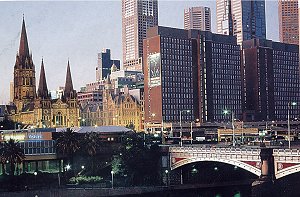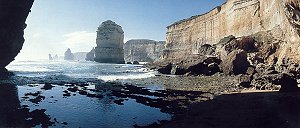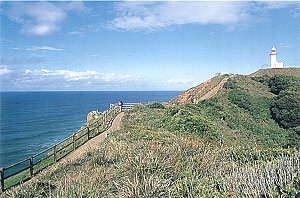

 MELBOURNE, CITY
OF CULTURE : Melbourne, established in 1835, is Australia's second
largest city with a population of around 3 million. For over a
century, from the 19th century gold rush, this was Australia's
establishment capital, and is still the fashion and food centre
of the country. The Yarra River flows through the middle of Melbourne's
historic central business district and under the Princes Bridge
beside Flinders Street Station. Lygon Street, Carlton has many
coffee bazrs, boutiques and pubs and one block away is the venerable
Melbourne University. Suburbs like Brighton Beach, beside Port
Phillip Bay, offer good sailing opportunities, plus access to
the cafes and seafood restaurants of neighbouring St Kilda. Melbourne's
grand Victorian era buildings are an example of the wealth created
by the 1850s gold rush. Complemented by the architecture of later
eras, Melbourne's central business district still conforms to
the orderly grid laid down by the city's founding fathers. City
trams at the top of Swanston Street and the beautiful 1903 City
Baths maintain the continuity of Melbourne traditions. In Brunswick
Street, Fitzroy, just north of the central business district,
buskers are found performing amid a gauntlet of ethnic restaurants,
coffee and wine bars, fashion shops and galleries.
MELBOURNE, CITY
OF CULTURE : Melbourne, established in 1835, is Australia's second
largest city with a population of around 3 million. For over a
century, from the 19th century gold rush, this was Australia's
establishment capital, and is still the fashion and food centre
of the country. The Yarra River flows through the middle of Melbourne's
historic central business district and under the Princes Bridge
beside Flinders Street Station. Lygon Street, Carlton has many
coffee bazrs, boutiques and pubs and one block away is the venerable
Melbourne University. Suburbs like Brighton Beach, beside Port
Phillip Bay, offer good sailing opportunities, plus access to
the cafes and seafood restaurants of neighbouring St Kilda. Melbourne's
grand Victorian era buildings are an example of the wealth created
by the 1850s gold rush. Complemented by the architecture of later
eras, Melbourne's central business district still conforms to
the orderly grid laid down by the city's founding fathers. City
trams at the top of Swanston Street and the beautiful 1903 City
Baths maintain the continuity of Melbourne traditions. In Brunswick
Street, Fitzroy, just north of the central business district,
buskers are found performing amid a gauntlet of ethnic restaurants,
coffee and wine bars, fashion shops and galleries.
THE
GREAT OCEAN ROAD : Winding several  hundred kilometres
from Geelong to Port Fairy, the sinuous Great Ocean Road is one
of Australia's most spectacular roads. Along it, the classic point
waves at Bells Beach make great viewing, especially during the
Easter professional surfing competition. Further on, near Port
Campbell, limestone cliffs battered by the sea have created kilometres
of dramatic forms, culminating in the spectacular Twelve Apostles-a
series of tall, sculpted rock chimneys stranded in the surf.
hundred kilometres
from Geelong to Port Fairy, the sinuous Great Ocean Road is one
of Australia's most spectacular roads. Along it, the classic point
waves at Bells Beach make great viewing, especially during the
Easter professional surfing competition. Further on, near Port
Campbell, limestone cliffs battered by the sea have created kilometres
of dramatic forms, culminating in the spectacular Twelve Apostles-a
series of tall, sculpted rock chimneys stranded in the surf.
 THE COASTEL HILLS : Beyond port Campbell National
Park, 25 million year-old limestone outliers, such as the Island
Archway, dot the coast. An hour's drive east of Melbourne are
the Dandenongs, a range of hills blooming with many spectacular
private gardens, including the Alfred Nicholas Gardens belonging
to the Burnham Beeches mansion. The founder of the gardens, Alfred
Nicholas, was the inventor of aspirin and lived here until Word
War ll. The Dandenongs can best be seen from Puffing Billy, a
nar row gauge steam train which travels 10 kilometres trough lush
bushland.
THE COASTEL HILLS : Beyond port Campbell National
Park, 25 million year-old limestone outliers, such as the Island
Archway, dot the coast. An hour's drive east of Melbourne are
the Dandenongs, a range of hills blooming with many spectacular
private gardens, including the Alfred Nicholas Gardens belonging
to the Burnham Beeches mansion. The founder of the gardens, Alfred
Nicholas, was the inventor of aspirin and lived here until Word
War ll. The Dandenongs can best be seen from Puffing Billy, a
nar row gauge steam train which travels 10 kilometres trough lush
bushland.